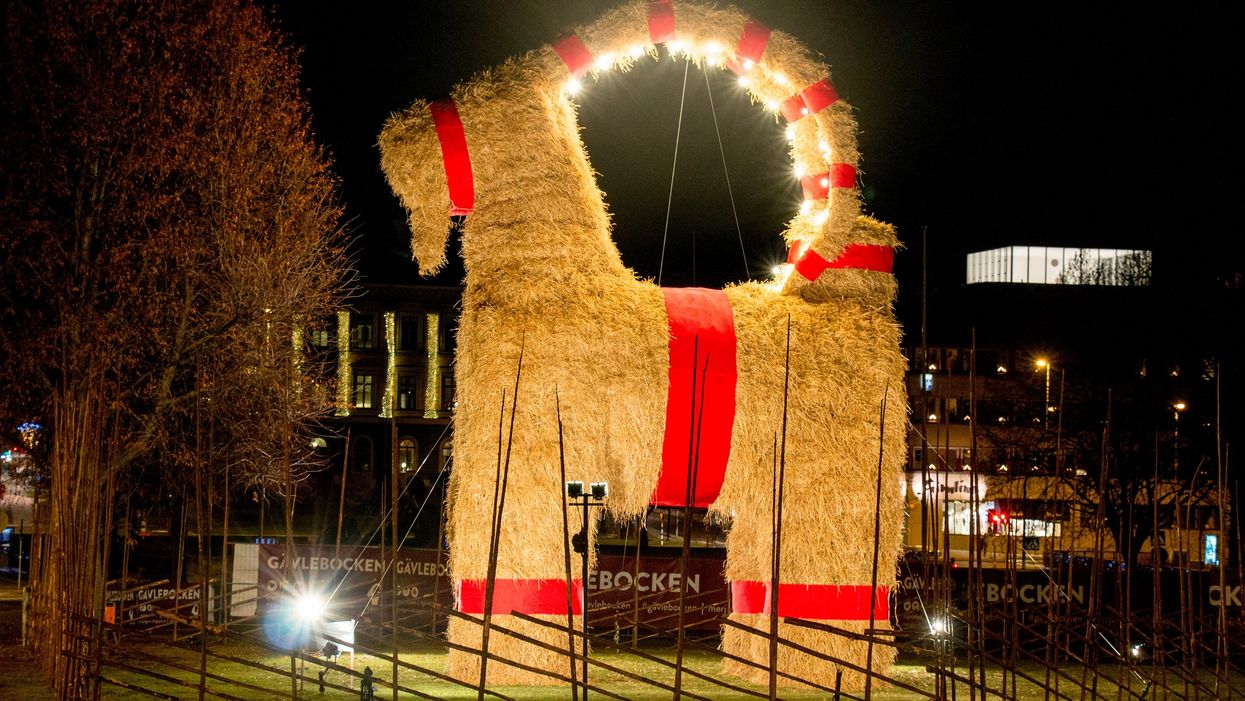
T’is the season to be jolly or whatever, but for one city in Sweden, it may well be the season where someone risks a criminal record to burn down a giant straw goat.
Yes, really.
Every year in Gävle, a cute straw goat – known as the Gävle goat or Gävlebocken in Swedish – is erected in Castle Square as part of the area’s Christmas celebrations. This year’s ‘inauguration’ takes place on Sunday.
It all sounds innocent enough, and that alone wouldn’t be enough for us to report on, but since it became a tradition in 1966, the goat has only survived the festive season on 18 occasions.
For all the other years the goat has been assembled in Gävle, it has been destroyed – more specifically, it’s been burnt down by members of the public who know straw is particularly flammable.
Though this is a goat, not Guy Fawkes. And before we get a letter in the post from some angry Swedish lawyers, we should probably mention that for those who build the goat every year, burning it down is something which they really do not want.
Sign up to our free Indy100 weekly newsletter
It’s also Very Much Illegal.
Yet that hasn’t stopped people, even when they faced growing challenges from people who very much did not want their goat turned to ash – who can blame them?
In its first year, it was burned down on New Year’s Eve. Three years later, in 1969, someone did the same.
A year later, two drunk adolescents burned it down. When local tradesmen weren’t so keen on their hard work being destroyed in 1971, the Natural Science Society of Vasaskolan took over goat-building duties, according to VisitGävle.se. Their goat burned down too.
In 1972, it wasn’t even burned down. It imploded.
Some years the fate of the goat was unexplained, such as in 1973, 1975 and 1977.
In a shock twist, the goat didn’t burn down in 1976 – it was hit by a car instead.
Two years people got a little ahead of themselves, burning down the goat in 1979 and 1989 ahead of it being assembled in Gävle.
The goat even made the Guinness Book of Records in 1985 when it was 12.5 metres tall, before, of course, it was burned down.
Gävlebocken received a bit of an upgrade in 1987 when he was heavily fireproofed by the city.
It didn’t stop it from burning down, though.
A year on, things got worse: you could actually place a bet in Britain as to whether you thought the goat would survive or not – that year, miraculously, it did.
When the world entered the 90s, a commercial sleigh was illegally constructed next to the goat. While a slightly irritating installation, it didn’t detract from the fact that someone still managed to successfully set the goat alight that year, 1991.
Some years, it wasn’t even the fault of humans that the goat was destroyed. A blizzard killed it off in 1998.
In 2001, the burning went international when a 51-year-old American tourist – thinking it was perfectly legal to burn down a giant straw structure of a goat – succeeded. He was convicted and spent 18 days in jail.
Things got silly four years later, when arsonists reportedly dressed as Santa Claus and a gingerbread man fired a flaming arrow at the goat, causing it to burn to the ground.
As the years went on, further protective measures were introduced.
2009 saw webcams put in place to spot any suspected vandals attempting to do something they shouldn’t be doing.
The authorities didn’t plan for a denial of service attack, however, which took the cameras offline, while the goat was burned down.
The goat survived in 2010, but reports surfaced of two men attempting to bribe someone guarding the goat to allow them to steal it by helicopter. It didn’t work.
The next year, Gävlesboken was covered in a layer of protected ice, only for that to melt and for the goat to be burned down.
The goat then survived four years on the trot, including the first year of the coronavirus pandemic in 2020, before burning down again a year later.
While the world awaits the next inauguration on Sunday afternoon (2pm UK time), we'll just have to see how long this year's goat will last.
Have your say in our news democracy. Click the upvote icon at the top of the page to help raise this article through the indy100 rankings.













